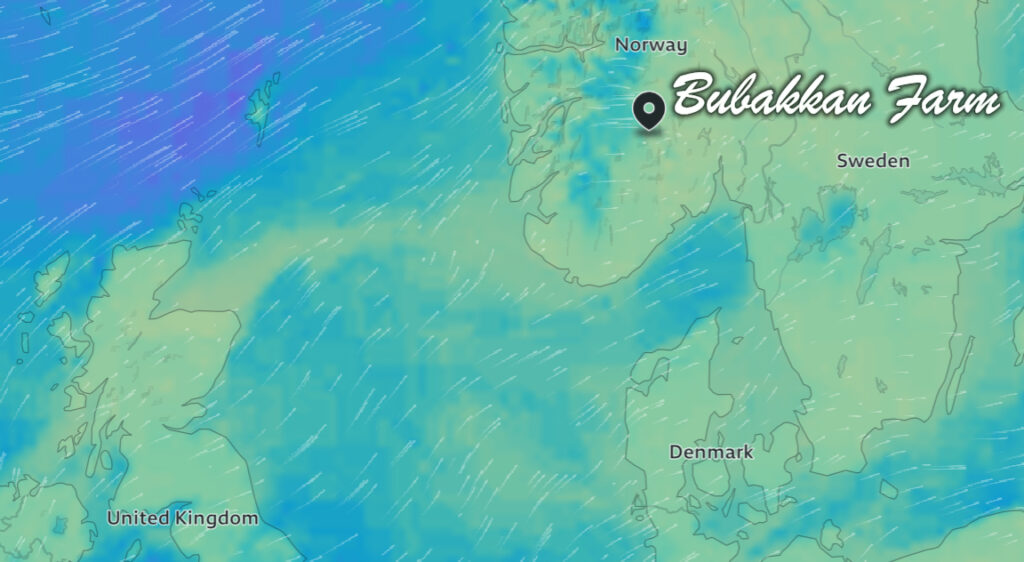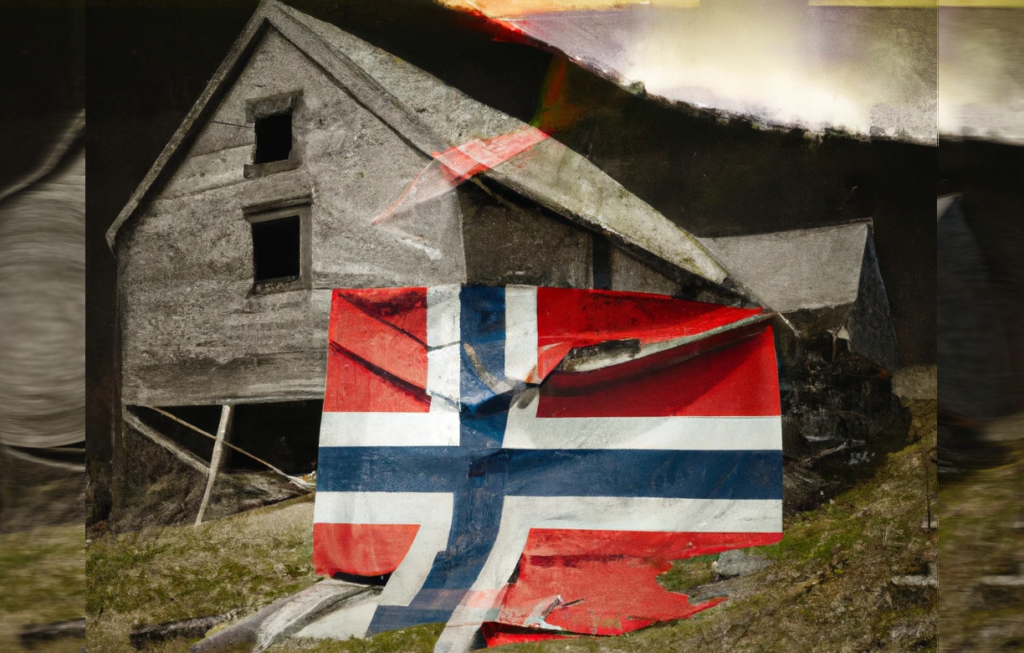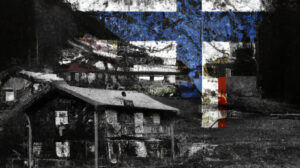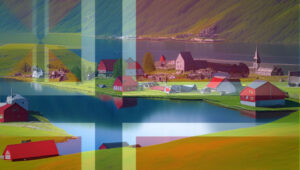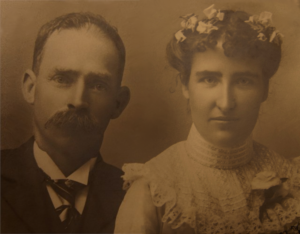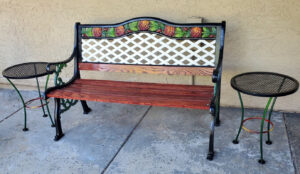Norway’s baby naming tradition before 1900 was rooted in patronymics, where each generation received a new surname and the first two boys’ and girls’ names were predetermined, linking each person to their family’s preceding two generations. Additionally, a placename tied each person to a particular farm or house, providing a unique identification of each person’s father, grandparent or other ancestor, and their farm or house name. This naming system was capable of identifying even out-of-wedlock children and can be used as a guide in investigating one’s ancestors, though it’s not entirely reliable due to so many duplicate names.
Patronymics is an old system. It has a long history that can be traced back thousands of years, but is no longer used in Norway. Starting in the 1600s, some families started using fixed family surnames, and by the 1900s, most families in Norway had adopted the use of a family surname that was passed down through the father. This change in naming conventions represents a significant shift in Norwegian culture and society.
When Norwegians left their home country to settle in America, they often altered their names to better fit in with American culture. This phenomenon plays a role in this story. But before we delve deeper into that aspect, let’s first introduce the key players of our narrative: Ben Gjerde and Kari Horn, two individuals hailing from Blooming Prairie, Minnesota, formerly known as Bjorn and Kari. They are highlighted in yellow on the right in the following chart.
Ben Gjerde and Kari Horn are my second great grandparents on my dad’s mom’s mom side. Ben and Kari started their family in Norway under traditional Norwegian customs. They were married and had four children in Norway. Then, in 1860, they immigrated to America, blended into American culture, and had another six children.
Coming soon! Watch this site for my next article titled, “From Norway to Minnesota, Ben and Kari’s Story.” It covers their family life in America, their children’s families, along with an exploration of their transition from traditional Norwegian customs to modern American life, well, modern enough for Minnesota in the 1860s.
This story is about Ben and Kari’s names and their ancestors.
Now let’s dive into the details of patronymics as generally applied in Norway and specifically applied to Ben and Kari’s ancestors.
First name: Give the child a given first name based on the following:
- first-born boy is named after his father’s father,
- first-born girl is named after her father’s mother,
- second boy was named after his mother’s father,
- second girl was named after her mother’s mother.
- If a child dies before the next child is born, reuse the name.
After the above first names are given, the pattern breaks down but generally speaking grandparent and other ancestor names were used.
Surname: Next, give them a surname identifying them as a child of the father. Each generation had a different surname. If the child was out of wedlock, or the father was not accepted then use the mother’s name. You take the parent’s first name and add “sen” for a son, and “datter” for a daughter. This can be redundant when recording a family so in records “sen” is freguently shortened to “s” and “datter” to “dtr”, “dr”, or just “d.” For example here are the parents of Ben and Kari. Ben Oleson in America was Bjorn Olsen in Norway.
- Bjorn Olsen‘s father is Ole Engebretsen the son of Engebret Olsen.
- Ben’s mother Rangdi Bjornsdatter is the daughter of Bjorn Knutsen.
- Kari Tollefsdatter‘s father is Tollef Tollefsen, son of Tollef ________.
- Kari‘s mother is either Kari or Ingeborg Iversdatter, daughter of Iver Nilssen.
Ben’s father was Ole Engebretsen so Bjorn’s surname at birth was Olsen, his name was Bjorn Olsen. His father was Ole so the spelling could be either Olesen or Olsen. By family tradition the spelling used was Olsen. Of interesting note, when Bjorn “Ben” arrived in America he took this tradition and Americanized it. He changed “sen” to “son” and he used the full “Ole” spelling of his father’s given name. Bjorn Olsen Gjerde used Ben Oleson for the first few decades in America.
Placename: The reuse of given names as names of your first two boys and first two girls led to too many people with the same name. To identify an individual person you connected them with their named residence, a house or farm. This frequently led to the placename changing over one’s life. You might have one placename when you’re born, another when you’re married, and yet another if you relocate. Sometimes placenames stuck, sometimes they did not. Frequently those placenames turned into modern permanent surnames especially by the year 1900. Historically farms in Norway can range in size from a single family home to a village resembling a small town.
Ben used the following placenames in Norway:
- Bubakken: Ben is known as Bjorn Olsen Bubakken on his marriage record. His first born daughter is known as Rangdi Bjørnsdatter Bübakken who, per patronymics, was named after Bjorn’s mother Rangdi Bjornsdatter.
- Gjerde: Their first born daughter died as an infant and per Norwegian custom, they gave their second born daughter the same given name of Rangdi. The second Rangdi was known as as Randi Bjornsdatter Gjerde in Norway. I believe the family moved from the Bubakken Farm to the Gjerde Farm circa 1858, but I’m still trying to confirm. There is a Gjerde Farm in Hemsedal, Buskerud today about 12 miles from the Bubakken Farm. It is situated nearby to Eikregardane and Røykingset. Could this be their last farm in Norway prior to emigrating?

Family Surnames: Starting in the 1600s some Norwegian families started adopting fixed surnames to carry with descendants. In records, men would just use the family name. In some records you’ll see “fodt” or “f.” in front of the name for family name especially for females as in Ragnhild fodt Stiruplyen Gunvallgaard. In this case she is Ragnhild Stiruplyen linked to the Gunvallgaard farm or house. In some records she might be referred to as Ragnhild Engebretsdatter f. Stiruplyen for Ragnhild daughter of Engebret using the family name Stiruplyen.
Some Fun, Apply to your name
If my parents applied this to me and my brother, our names would not be Michael Alan Prestwood and Brian Keith Prestwood, they would be based on our grandfathers and my dad. My older brother would be Lester Lestersen Milpitas. We both ended up living in Antelope about a half mile apart so we would have added or switched to “Antelope” as our placename in 1995 when we moved here. My name would have been created after my mom’s dad and my dad. In 1995 my name would have evolved to Ralph Lesterson Antelope. Pretty trippy names from my viewpoint.
Now let’s take a look at an example of a typical Norwegian name; specifically, the evolution of Ben’s name during his life in Norway, and in America:
- 1826: Bjorn Olsen, birth name
- 1854: Bjorn Olsen Bubakken when married
- 1858: Bjorn Olsen Gjerde, assumed final Norwegian name
- 1860: Ben Oleson, first American name
- Circa 1888: Benjamin “Ben” Gjerde, second American name
- 1891: Bjorn Olson Gjerde, church death record with spelling Jerde
Although all of these name changes occurred more than a century ago, I can piece together what likely happened from records, family letters, and because of the fairly consistent use of traditional names.
Ben’s full Norwegian name which identifies the person throughout his life is Bjorn Olsen Bubakken Gjerde. You can learn much by a traditional Norwegian name. In this case, Bjorn Olsen is Ben’s name and he lived on the Bubakken and Gjerde farms during his time in Norway. When Ben and Kari were getting married, Ben was living on the Bubakken Farm and Kari was from the Hornet Farm. By tradition, I can imagine an uncle in the old country who is familiar with the family formally introducing Ben and Kari at their wedding as follows:
“I now present to you Bjorn Olsen and Kari Tollefsdatter. Kari, the daughter of Tollef Tollefsen of the Hornet Farm, and her husband Bjorn will both reside with Bjorn’s father Ole Engebretsen at the Bubakken Farm.”
Now that’s an introduction and definitely uniquely identifies Bjorn and Kari as a couple and as individuals. We can deduce this fancy introduction based on their names: Bjorn Olsen Bubakken and his father Ole Engebretsen Bubakken, as well as Kari Tollefsdatter Hornet, and her father Tollef Tollefson Hornet. Ben’s father is known as Ole Engebretsen Bubakken. So the placename of Bubakken was likely Ben’s childhood home and he was likely known by the name Bjorn Olsen Bubakken for most of his life in Norway, but his name was Bjorn Olsen and Bubakken and Gjerde are just placenames used mostly on official records.
I believe they moved from the Bubakken farm to the nearby Gjerde farm about 1858. If true, perhaps someone would introduce Bjorn at a formal event like this:
“This is Bjorn, son of Ole Engebretsen of the Bubakken farm. Bjorn formerly of the Bubakken Farm, now of the Gjerde Farm. He is the second born male named after his mother’s father Bjorn Knutsen of the Hogehaug Farm.”
To be clear, I doubt these farmers talked like this, and I have no idea if Norwegians ever introduced each other this way, but I sure can imagine it based on their names and the importance of this tradition in Norway. And, it’s fun.
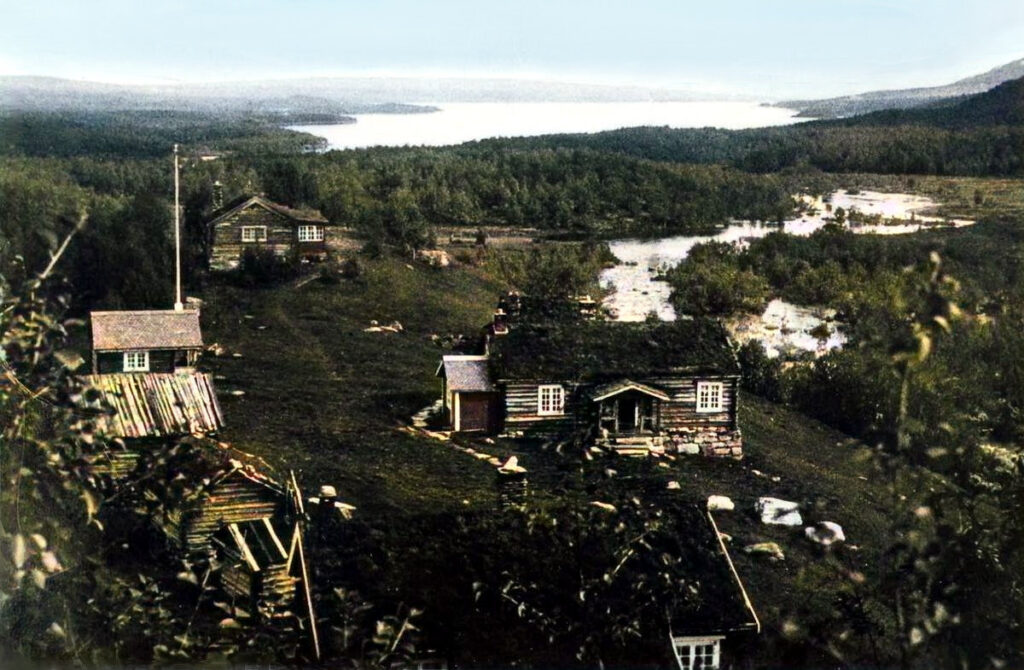
When Bjorn Olsen Gjerde came to America in 1860 he changed his name to the American name Ben Oleson. Later in life he changed his name to Gjerde. There were lots of people using their surnames so Olson was extremely popular in America. Around this time there was a movement for Norwegians to use their placenames over their surnames for the fixed family surname. I assume that is why Ben changed his name from Oleson to Gjerde but I have no evidence. Ben and Kari’s children carried on both the Olson/Olsen and Gjerde surnames.
- Coming soon! From Norway to Minnesota, Ben and Kari’s Story
My Norwegian Ancestors going back to the 1600s
Now that we’ve presented patronymics let’s explore what I know of my Norway ancestors. I’ve learned a bit about my ancestors going back to the 1600s. For context, here is a map of Norway followed with a brief history of Norway from 1600 to 1850.
During the 17th century, Norway was a small country under the rule of the Danish monarchy as part of the Danish-Norwegian realm. Its economy thrived on the timber trade with neighboring countries, until the Thirty Years’ War brought famine and disease. Despite these setbacks, the country continued to develop its economy and infrastructure, constructing new roads, canals, and harbors. In the 18th century, a nationalist movement emerged, fueled by Enlightenment thinkers, leading to Norway’s autonomy from Denmark in 1814. The mid-19th century saw the growth and prosperity of shipping and fishing industries, accompanied by sweeping political and social reforms. Despite challenges, Norway’s unique identity remained strong, shaping its future.
In the 1850s, Norway was facing economic hardship and overpopulation. Many Norwegians sought a new life in America. Some estimates are that as many as 800,000 immigrated to the mid-west. Many landed in Minnesota, drawn by its lush forests and fertile farmland. These brave pioneers left behind their homes and families, braving the harsh Atlantic crossing to seek a better future. These brave pioneers sought a better life and a chance to thrive in the land of opportunity. With the Minnesota landscape resembling their native Norway, they set up vibrant communities and embraced their new American identity.
With that context, let’s take a look at both Ben’s and Kari’s family charts. First up, Bens childhood family. You will see their family is a perfect example of patronymics.
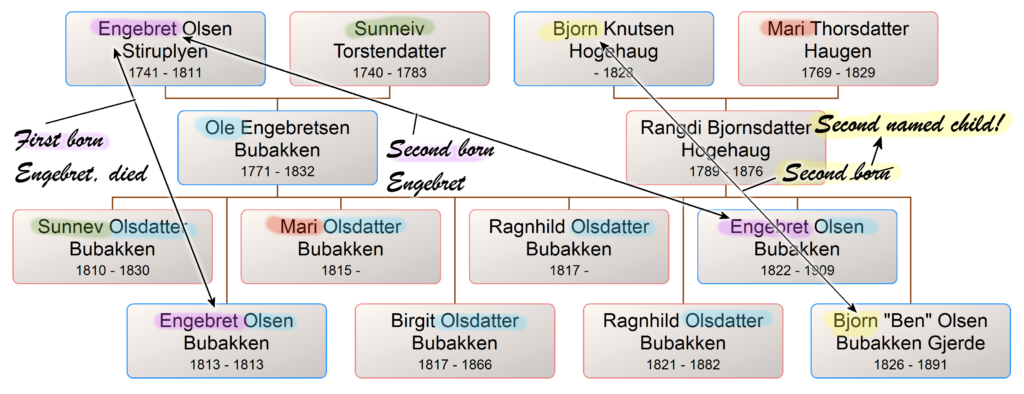
Although Bjorn was the second named boy, he was the third born boy. The first born boy died. In the chart in purple, notice Bjorn’s older brothers Engebret. The first Engebret was born in 1813 and died the same year. Also in the chart notice the first two born girls are Sunnev (highlighted in green), and Mari (highlighted in red). The first born girl Sunnev was named after Ole’s mother Engebret Olsen Stiruplyen, and second born Mari was named after Rangdi’s mother Rangdi Thorsdatter. Still, a perfect example of patronymics. Birgit and Ragnhild were the 3rd, and 4th named daughters. Unfortunately the first Ragnhild daughter born in 1817 died so the next daughter is also Ragnhild.
Note: Unfortunately Ben and Kari will experience the same pain. Ben and Kari’s first child was baby girl Randi (1855-1855) named traditionally after Bjorn’s mother. They would name the next girl Randi (1859-1949) also after Bjorn’s mother. The records record their first born as Randi Bjornsdatter Bubakkan and the second daughter as Randi Bornsdatter Gjerde.
Kari Horn’s Childhood Family Name Check
People being people, patronymics is not a perfect system. Let’s take a look at Kari’s childhood family and point out a few things as to why it’s not a clean example of patronymics. For the record, I believe this chart is accurate but missing relatives. It was built using official records and family information passed down. How many relatives are missing? I’m not sure. Can I rely on patronymics to fix and fill in extra relatives? Absolutely not. At least not using names alone.
Ok, time for some analysis. First, notice in yellow highlight that Kari is named after her mom’s mom likely indicating she is a second named daughter, but I have yet to find her older sister. Next notice that neither of Kari’s two known brother’s are named Ola after her mom’s dad. This indicates there might be at least two missing older brothers the oldest two of which would be named Tollef and Ivar. Also notice that I currently have Kari’s mom with the name Kari, not Ingeborg. For Kari’s mom, some records indicate Ingeborg, some Kari. Based on patronymics, I assume she is Ingebjorg, named after her father’s mother indicating she was the first named daughter. If true, then she does not have any older sisters.

The rules of genealogy are that you cannot simply add relatives based on any naming scheme. As stated above, I believe the above chart is accurate. Furthermore, I believe the Kari Horn side of the family just did not believe in patronymics as strictly as Bjron’s family did. However, based on patronymics, we can add one test relative at a time, search for records, then remove them if we do not find a match.
In yellow in the following chart are some possible search subjects complete with assumed placenames and estimated birth dates. Notice that we can assume Kari’s dad’s dad’s name is Tollef because of his Tollefsen surname. That means we can assume the oldest brother of Kari is Tollef Tollefsen like her dad. Furthermore, we can guess that his placename is the same Intelhuus as her older brother. Well, these are all searches we can try. At this point let me suggest that you should only add these names to your tree if you find official documents that match. Do not add them based on other modern family trees alone.

For Kari’s potential older siblings, I found nothing. Well, at most it kind of confirms my original suspicions that Kari’s family just did not believe in the old customs as much as Bjorn’s family. I will keep looking though. For potential first named boy Tollef and the potential older sister, I found nothing. For potential second born Ivar, I did find one potential record for a Iver Intilhus, but it was undated and only a database record, no image so I couldn’t use it.
I had much better luck with earlier ancestors when the patronymic system was in use more strictly. For example, I did not know the parents of Kari’s grandparents on her dad’s mom side. I was able to find them and firm up the birth year for her grandmother Ingeborg Iversdatter to 1744 (highlighted in yellow below).
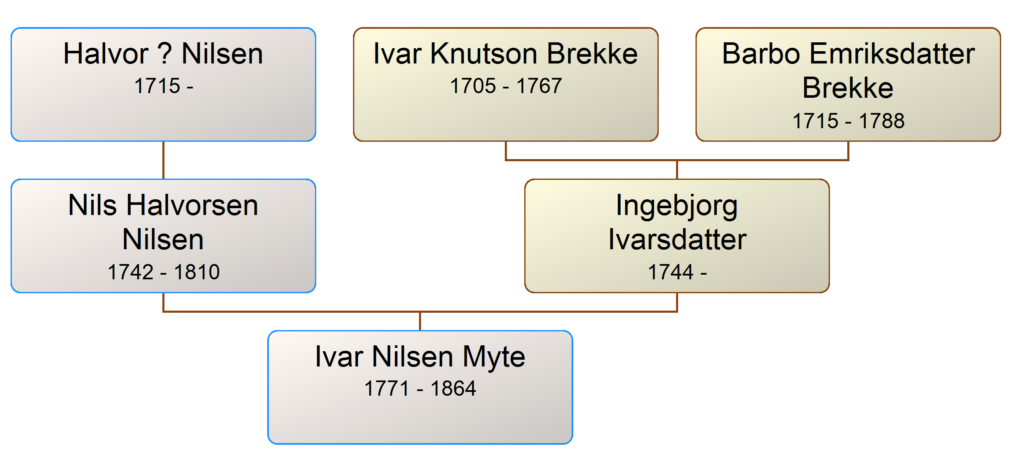
Conclusion
Imagine traveling back in time to 1853 and you walk onto the Bubakken Farm. You meet a young man Bjorn and a woman, Bjorn says:
“I’m Bjorn Olsen, son of Ole Engebretsen. This is my fiancé Kari Tollefsdatter, daughter of Tollef Tollefsen from the Horn Farm.”
You are struck by the intricate naming system that both reminds you of who their father is and what farm they are from. Fast forward to modern times, and the Norwegian tradition of patronymics has evolved, with most families adopting a family surname passed down through the father. Bjorn’s family descendants are using Olsen, Bubakken, and Gjerde surnames. Kari has two brothers and their descendants are using Tollefsen and Horn surnames. For your family history going back into traditional Norway, keeping these concepts in mind and learning the specific surnames and placenames used in Norway will guide you in your research.
Coming soon! Watch this site for my next article titled, “From Norway to Minnesota, Ben and Kari’s Story.” It covers their family life in America, their children’s families, along with an exploration of their transition from traditional Norwegian customs to modern American life, well, modern enough for Minnesota in the 1860s.
–END–
*** Research Notes ***
Ruby Heen 1950s Family History Book
THE HALL, DOCKEN (DOKKEN) – GJERDE GENEALOGY. Tollef Docken, Randi Gjerde Family History by Ruby Heen of Grand Forks, North Dakota. These book pages are the only key I have to linking Emma Gjerde as the person born Ingeborg Bjornsdatter Olsen to Ben Gjerde and Kari Horn. They are also key in finding the correct ancestors in Norwegian records.
Hemsedals Slektshistorie 1693-1975 Book
You can sometimes get a copy of this book from eBay. I got mine for $55 in 2023. It was selling for $400 on Amazon at the time.

Ancestry.com Trees
My 3rd or 4th cousin David Aagaard has an impecably researched ancestry.com tree. I relied on his notes as guides to some of the more difficult to find Norwegian records. My tree is not bad either, and you can compare differences in the two if you wish.
- David Aagaard Family Tree, owned by David Aagaard
- Prestwood-Unsicker v2=Primary, owned by me Mike Prestwood
In general, you have to be a paying ancestry.com member to view other public member trees.
Bubakken and Gjerde Farms
I don’t know if I have either of these correct, but this is my current best guess. In the following map are both the Bubakken and Gjerde farms, well, at least a Bubakken, and a Gjerde farm.
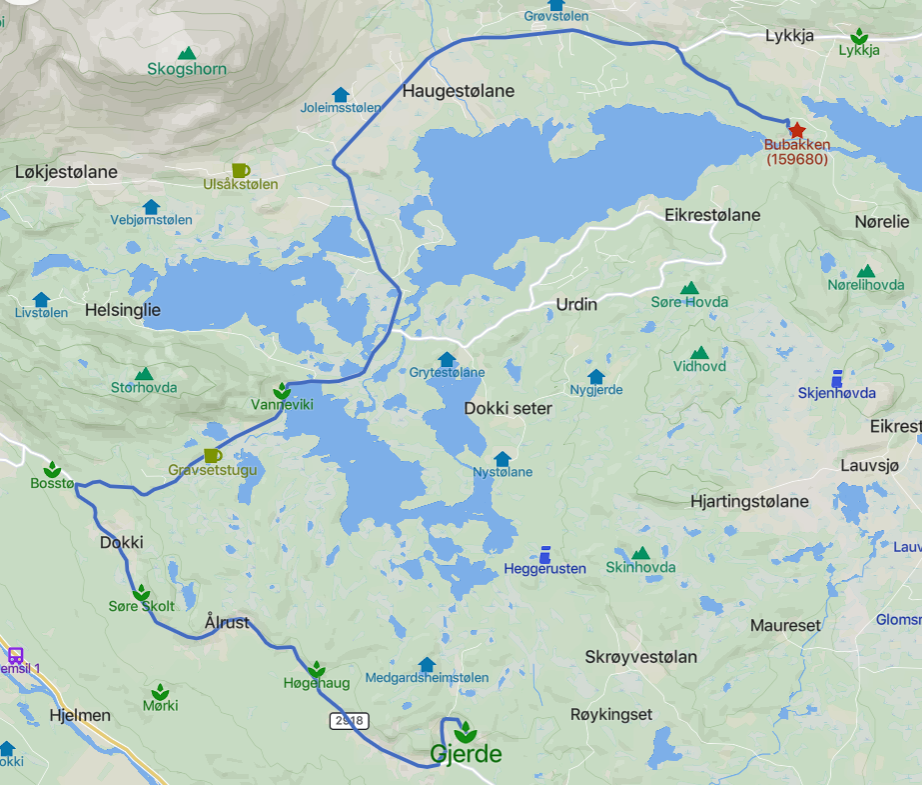
To orient you, here is a weather map. The Bubakken Farm is for sure very near Hemsedal.
